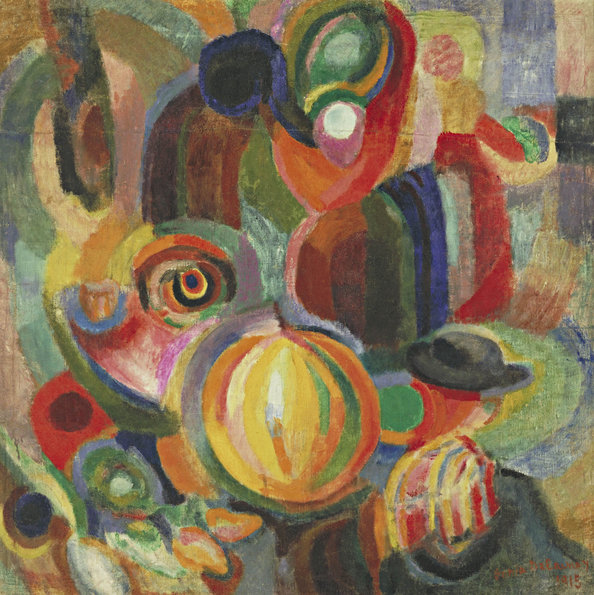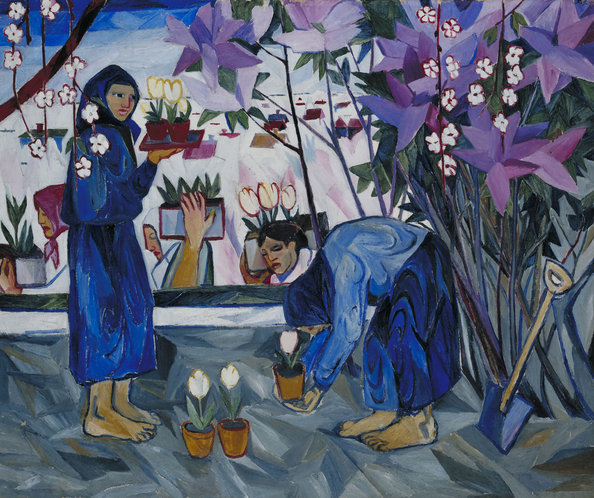An impressive panorama of Modern Art: First presentation of the women artists of THE STURM at the SCHIRN
The STURM heralded the advent of modern art. Originally the name of a magazine founded in 1910 devoted to promoting expressionist art, the term STURM (English: STORM) soon assumed the character of a trademark. Herwarth Walden, the publisher of the journal, also founded the STURM gallery in Berlin in 1912. Numerous women artists, including many from other countries, were presented in Germany for the first time at his gallery. As a movement, the STURM represented a program—one that opposed conceptual barriers, the establishment in general, and the bourgeois character of Wilhelminian society and advocated the total freedom of all arts and styles.
Composed of friends with similar interests, the STURM network served as a forum for intensive and animated discourse on the ideas, theories, and concepts of the avant-garde. The additional STURM evenings, the newly founded STURM academy, the STURM theater and bookshop as well as occasional balls and a cabaret offered the artists of the STURM a variety of platforms and made the diverse artistic currents and tendencies in Berlin during the years from 1910 to 1930 accessible to a broad public. The Schirn Kunsthalle Frankfurt is devoting an extensive topical exhibition to the women of the STURM beginning on October 30, 2015.

For the first time ever, eighteen women STURM artists representing Expressionism, Cubism, Futurism, Constructivism, and the New Objectivity will be presented in a comprehensive exhibition featuring around 280 works of art. The presentation is a somewhat different survey of the most important currents in avant-garde art in Berlin in the early years of the twentieth century. Among the best-known artists represented in the show are Sonia Delaunay, Alexandra Exter, Natalja Goncharova, Else Lasker-Schüler, Gabriele Münter, and Marianne von Werefkin. They are joined by a number of largely unknown or less familiar artists, among them Marthe Donas, Jacoba van Heemskerck, Hilla von Rebay, Lavinia Schulz, and Maria Uhden.
Each of the eighteen women artists of the STURM will be presented along with her most important works in a separate room at the exhibition. They are artists from Germany, the Netherlands, Belgium, France, Sweden, Ukraine, and Russia whose works were exhibited at the STURM gallery or published in DER STURM magazine. The writer and composer Herwarth Walden (1878−1941) exhibited works by Wassily Kandinsky, Paul Klee, Oskar Kokoschka, and Marc Chagall, the artists of Der Blaue Reiter, and the Italian Futurists, but he also actively promoted well over thirty women painters and sculptors strategically and without bias. He was regarded as a visionary and a pioneer on behalf of abstraction and modern art in general, and he united the international avant-garde with his programs.

For many women artists, the STURM represented their first big chance, for in the early years of the twentieth century they were neither fully recognized by society nor did they have access to academic training comparable to that of their male colleagues. The life stories, personal circumstances, and critical reception of the eighteen women artists of the STURM are all very different, and their styles vary considerably as well. Yet viewed as a group, they represent an impressive panorama of modern art.
“Through their ideas and visions, the STORM Women played an instrumental role in the development of modern art. Some of them are still quite familiar to us today, while others have been unjustly forgotten. However, they all played a part in ensuring that new currents in art, such as Cubism, Expressionism, and Constructivism, would gain the recognition they deserved. With this exhibition featuring impressive major works by the eighteen women of the STURM, the Schirn focuses attention on the crucial role played by these artists, while offering insights into the history of their reception. It is an extraordinary exhibition devoted to modern art, the role of women in art, and the significance of a gallery and its strategic program in Berlin during the 1920s—an exhibition featuring famous names and famous works as well as numerous astonishing rediscoveries,” states Max Hollein, Director of Schirn Kunsthalle Frankfurt.
An exhibition featuring famous names and famous works as well as numerous astonishing rediscoveries
In the words of exhibition curator Dr. Ingrid Pfeiffer: “Walden was unique among the art dealers of his era. He promoted male and female artists with equal vigor and paid no attention to the typical prejudices of the period. Roughly one-fifth of the STURM artists were women. That distinguished him from many of his fellow gallery owners, such as Paul Cassirer, Alfred Flechtheim, and Wolfgang Gurlitt in Berlin and Heinrich Thannhauser in Munich. Although the subject of women in visual art was openly discussed in many publications during those years, and their claims to originality and creativity were generally denied, Walden refused to be influenced by such discourse. It was the individual work of art that was most important to him. He consistently promoted new the most recent developments in art and never wavered in the face of incomprehension or confrontation. His thoughts and actions were transcended national boundaries, and he constantly sought out networks in all artistic and intellectual fields.”

A FULL LIST OF THE ARTISTS PRESENTED IN THE EXHIBITION Vjera Biller (1903–1940), Marcelle Cahn (1895–1981), Sonia Delaunay (1885–1979), Marthe Donas (1885–1967), Alexandra Exter (1882–1949), Natalja Goncharova (1881–1962), Helene Grünhoff (1880−?), Jacoba van Heemskerck (1876–1923), Sigrid Hjertén (1885–1948), Emmy Klinker (1891–1969), Magda Langenstraß-Uhlig (1888–1965), Else Lasker-Schüler (1869–1945), Gabriele Münter (1877–1962), Hilla von Rebay (1890–1967), Lavinia Schulz (1896–1924), Maria Uhden (1892–1918), Nell Walden (1887–1975), Marianne von Werefkin (1860–1938).